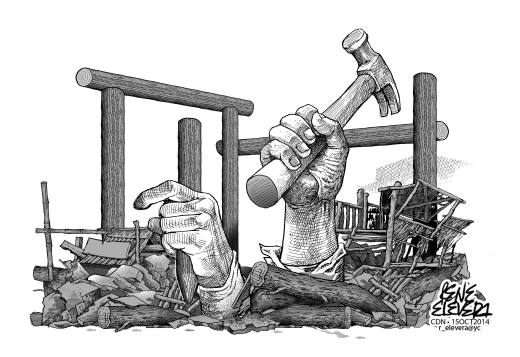It has been a year since an earthquake measuring 7.2 on the Richter scale battered Bohol and portions of Cebu.
The tremor, described by Phivolcs as equivalent to 32 exploding Hiroshima atomic bombs, killed 211 and displaced more than 95,000 families in Bohol.
Twenty municipal and city halls were destroyed while 15 others were damaged. Three churches were flattened while 22 others were damaged in varying degrees. At least 10 of these churches were considered heritage churches.
Cebu was better off – eight churches were damaged including the belfry of the Basilica Minore del Sto. Nino. Several government offices were also declared unsafe for occupancy including the Palace of Justice and the Cebu City Medical Center.
What has happened since then?
The judges in Cebu and their staff are forced to hold trials in Qimonda I.T. Center near the port area as the Supreme Court has yet to find the budget to build a new Palace of Justice.
Cebu City government is still raising funds to build the new CCMC on its old location along Natalio Bacalso Avenue.
In Bohol, not a single municipal or city hall has been rebuilt or repaired due to the absence of funds from the national government.
Several roads and bridges, government buildings, hospital and health centers are still in disrepair.
Local government units have to rely on help from private organizations, nongovernmental organizations and civic groups because support from the national government is wanting.
Of the P12 billion asked by the province, only P2.64 billion was released last June. But the funds cannot be used because procedures have to be followed.
One is local officials have to sign a memorandum of agreement that they are capable of doing the rehabilitation. Those who cannot will have to be assisted by the provincial government.
The MOA was signed only last Sept. 22, almost a year after the earthquake.
Unfortunately, the funds cannot be used because the Department of Interior and Local Government will have to validate each program of works and estimates submitted by the local government unit.
That will take a lot of time.
But the Boholanos didn’t just sit idly while waiting for help to arrive.
Instead, the provincial government is working to bring back its tourists after suffering a slump following the quake.
So far, the numbers are good after the province decided to use the “effects” of the earthquake as an added attraction to come and visit the province.
Included in the package now are the ruins of the old churches and the new five geological sites that emerged after the tremor, including the new fault line in Inabanga town.
At 8:12 a.m. today, the bells in Bohol will ring, not only to remind the public of the destruction caused by the earthquake but to show how they have been united to overcome the adversity despite the lack of support from the national government.
Disclaimer: The comments uploaded on this site do not necessarily represent or reflect the views of management and owner of Cebudailynews. We reserve the right to exclude comments that we deem to be inconsistent with our editorial standards.

